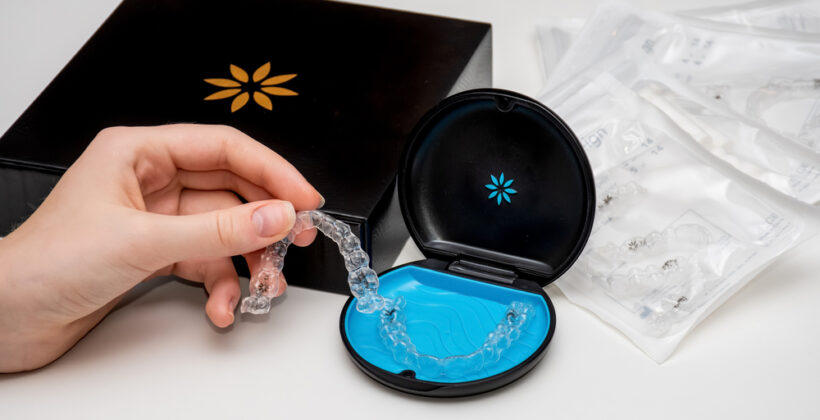At first blush, Invisalign sounds absolutely awesome! The clear, custom-made aligners are practically invisible, and they’re also removable. Treatment time is less than that of traditional braces, and Invisalign features no wires or brackets to irritate sensitive soft tissues in your mouth. Wow!
But what’s the fine print? What are orthodontists and dentists not telling patients about this revolutionary treatment? In today’s blog, we’ll answer the top five unusual Invisalign questions people have searched for on Google, so you can know the full story before you commit to treatment.
What are the hardest words to say when wearing Invisalign aligners?
Because of their snug fit, Invisalign doesn’t often cause trouble with pronunciation and enunciation. Some patients, however, find that the sounds of s, z, and share a bit different when wearing aligners. As for the sh sound, you could notice a bit of a lisp. Rest assured, it’s not permanent! You might even overcome this effect the longer you wear your aligners.
Try singing out loud to practice pronunciation while wearing aligners. This trick can help you adjust to speaking as clearly as possible while wearing Invisalign.
What is the most painful stage of Invisalign treatment?
Your very first week wearing Invisalign will probably bring some aches and pains to your teeth and jaws. The aligners will likely feel tight, but as teeth begin to shift, the tightness will dissipate.
To combat this mild to moderate discomfort, drink cold water, suck on ice, or wrap a bag of frozen peas (or an ice pack) in a cloth and place them against your cheek. You can also take over-the-counter pain medicine as per the label’s instructions or apply OraJel to painful areas. Also, avoid hard foods like nuts while adjusting to wearing your aligners. Lastly, rinse with salt water to help heal irritated soft tissues.
What’s the worst mistake you can make with Invisalign?
 One of the best attributes of Invisalign is its transparency. To maintain their clear appearance, aligners should not be subjected to staining foods and drinks. Only drink water while wearing your aligners, or use a straw, and always remove your trays when eating a snack or a meal.
One of the best attributes of Invisalign is its transparency. To maintain their clear appearance, aligners should not be subjected to staining foods and drinks. Only drink water while wearing your aligners, or use a straw, and always remove your trays when eating a snack or a meal.
Should your Invisalign trays discolor, soak them in one part white vinegar and three parts water for 20 minutes. Then brush the trays with a clear, mild dish soap and thoroughly rinse them before wearing.
Which teeth are the hardest to straighten with aligners?
Lateral incisors, which are the smallish teeth on either side of the center, upper front teeth, are the most difficult to move. Because lateral incisors have less surface area than other teeth, the aligners have less area on which to apply pressure to these teeth. Your lateral incisors will move, just not as quickly as larger teeth.
What are the downsides to wearing Invisalign?
Speech – The potential for minor pronunciation issues is described above.
Cheek biting – When your teeth move, your mouth has to functionally adapt to their new position. During the adjustment period, you may bite your cheeks or tongue. If you do, simply rinse with antibacterial mouthwash. If your aligner has a rough edge, Dr. Glud can file it down to improve comfort.
Dry mouth – Wearing a foreign object–your aligners–can cause temporary inflammation of soft oral tissues, which in turn prompts the body to produce less saliva. Stay hydrated, use a room humidifier while sleeping, and keep artificial saliva spray or gel on hand for instant moisture.
Headache and jaw pain – Mild to moderate jaw pain is described above, along with treatment ideas. A headache can also develop, especially if your jaws tend to clench or grind as they adapt to changes in occlusion (how upper and lower teeth fit together when you close your mouth). Over-the-counter ibuprofen or acetaminophen will relieve both jaw pain and headaches.
Receding bleeding gums – Keeping your teeth, gums, and Invisalign aligners clean is imperative to maintaining good dental and gum health. Some patients experience gingivitis, the early stage of gum disease, as a result of not removing aligners when eating and drinking. Also, use only a soft-bristled toothbrush and do not brush your teeth too harshly.
Schedule an Invisalign Consultation Today
If you live near Lombard, IL, call Dr. Julie Glud today at 630-629-5700 and schedule your Invisalign consultation. After evaluating x-rays, records, and oral health, Dr. Glud will talk with you about your case and answer all of your questions. Remember, no question is a bad question! At Dental Care of Lombard, we want to empower you to make informed decisions about your oral health.

